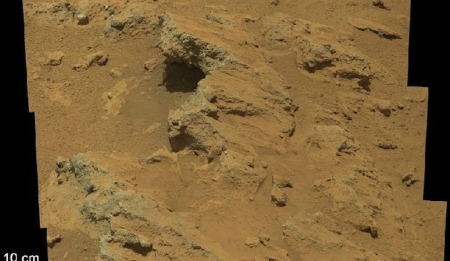Mars Curiosity landed in the right place alright! Just a few steps from touchdown the one ton rover snapped this image showing what planetary geologists (Areologists?) say is a lead pipe cinch for an alluvial fan, i.e., freely flowing water:
Wired — In another sandy light-colored rock that Curiosity passed, named Link (above), the rover spotted clasts that had fallen to the ground, creating a pile of stones that had been liberated from the rock. Both Hottah and Link were made of “a different type of material, one we hadn’t seen on Mars before,” said Rebecca Williams of the Planetary Science Institute in Tucson, Arizona during the briefing.
Along with material seen at the Goulburn scar, which was uncovered when Curiosity’s lander rockets disturbed the ground, these rocks add up to a picture of an ancient stream bed that once flowed through this area. Judging from the size of the gravel that was carried, scientists estimate that water likely ran at a steady two miles per hour and came to about ankle or hip height.


… about ankle or hip height.
Not quite the degree of precision we’ve come to expect from the Curiosity team (unless they calibrate such calculations according to a very short-legged person).
That pile of gravel in the picture of Link looks like what you’d find on the bottom of many Michigan streams or Great Lakes shorelines. Hmm – ankle to hip deep – a trout stream on Mars? :)
They found evidence of running water. What next? Indoor plumbing and flush toilets?